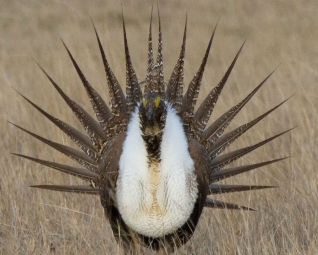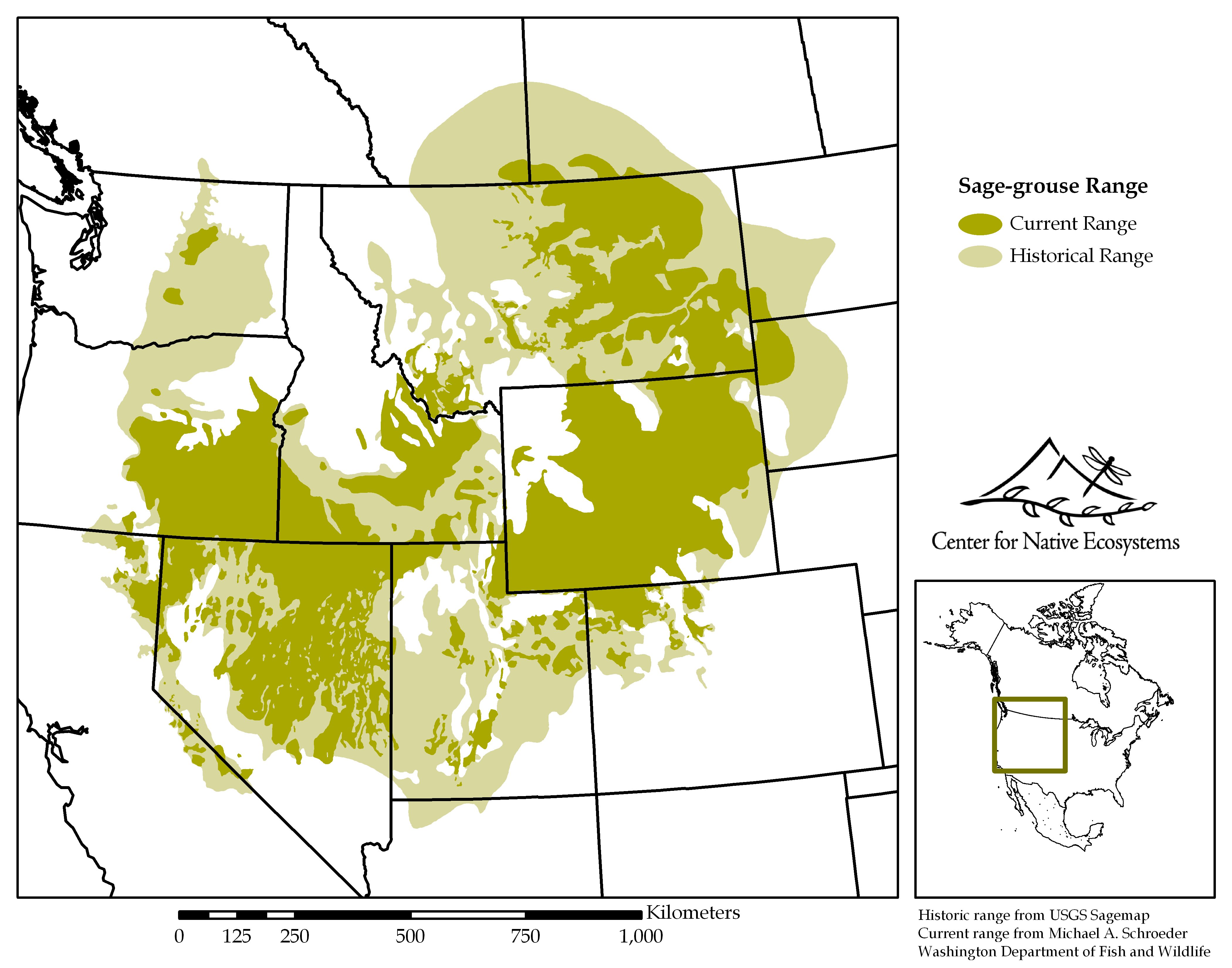Nine other Western States Still Not Out of the Woods
The U.S. Fish and Wildlife Service (FWS) ruled today that the Bi-State population of greater sage-grouse, found in Nevada and California, does not require the protection of the Endangered Species Act (ESA).
The U.S. Fish and Wildlife Service declared the Bi-State population of greater sage-grouse a Distinct Population Segment (DPS) under the ESA in 2010 because genetic analysis shows it has been separated from other greater sage-grouse for thousands of years and the genetic differences are significant.
In October 2013, the Service proposed listing the Bi-State DPS as threatened under the ESA based on significant population declines due to the loss and fragmentation of its sagebrush habitat from urbanization and associated infrastructure development, encroachment of sagebrush by conifers, and a vicious cycle of wildfire and fire-adapted invasive grasses. These threats, combined with the relatively limited number of birds, the small population size and their isolation, were determined to pose a significant threat to the species.
The area in question straddles the California-Nevada border, where biologists estimate that between 2,500 and 9,000 of these ground-dwelling birds inhabit about 4.5 million acres of high-desert sagebrush.
The Service is withdrawing this proposal in large part because of the success of the Bi-State Action Plan. The plan is the product of the Bi-State Area Local Working Group, comprising federal, state and local agencies and landowners from Nevada and California, which has been pursuing sage-grouse conservation since the early 2000s. Since then, the working group’s technical advisory committee has finalized plans on nearly 80 science-driven conservation projects specifically designed to reduce identified threats and protect the sagebrush-steppe habitat.
The working group’s executive oversight committee has raised more than $45 million in federal and state funding to ensure the projects are implemented and completed over the next 10 years. Long-term projects implemented under the Bi-State Action Plan include population monitoring, urbanization abatement measures, livestock management, wild horse management, pinyon and juniper removal, disease and predation studies and other habitat improvement and restoration projects.
Agency Count Almost on Parity with Bird Count
The working group member organizations almost outnumber the sage-grouse population being protected: private landowners in California and Nevada, Nevada Department of Wildlife, California Department of Fish and Wildlife, Nevada Division of Forestry, California State Parks, University of Nevada Cooperative Extension, nongovernmental organizations such as Nevada Wildlife Federation, Washoe Tribe of California and Nevada, Los Angeles Department of Water and Power, Bureau of Land Management, U.S. Forest Service, Natural Resources Conservation Service, U.S. Geological Survey, Department of Defense and the U.S. Fish and Wildlife Service.
“This partnership between California and Nevada serves as a model for effective conservation of the Greater sage-grouse in other Western states,” said California Natural Resources Agency Secretary John Laird.
Taxpayer Tab for Sage-Grouse Conservation Plan, Work: $75 Million to Date
A key factor in the decision not to list the bird was the development of The Bi-State Action Plan, a conservation plan developed by partners in the Bi-State Local Area Working Group over the past 15 years and secured with $45 million in funding. This adds to nearly $30 million worth of conservation work USDA and other partners have already completed to implement this plan.
Along with withdrawing the listing proposal, the U.S. Fish and Wildlife Service is also withdrawing proposed rules under section 4(d) of the ESA and the proposed designation of critical habitat.
Conservation work on private lands – through easements and habitat restoration – has played an important role in connecting national forests and other public lands, working to keep habitat intact. The U.S. Department of Agriculture’s Natural Resources Conservation Service has already invested nearly $20 million in conservation assistance to ranchers through this effort. This has helped ranchers protect 7,300 acres of key summer habitat through easements, with an additional 4,500 acres in process. This investment has also helped them remove invading juniper and pinyon trees, enhancing nearly 4,000 acres of important sagebrush-steppe habitat.
This summer, the Forest Service will begin treatments to improve sagebrush ecosystem health on 29,000 acres of key habitat for the sage grouse.
11 Western States Serve as Home to Sage-Grouse, Listing Decision Due Sept. 30, 2015
The U.S. Fish and Wildlife Service is concurrently conducting a separate status review for the greater sage-grouse across its 11-state range. In 2010, it determined the greater sage-grouse was warranted for protection but that action was precluded by higher priorities. A determination on whether the species still requires protection is due Sept. 30, 2015.
Nevada Governor Brian Sandoval applauded the group’s efforts to develop conservation actions that preclude the need to list the species while still allowing for sustainable economic development. Sandoval is chairman of the Western Governors’ Association.
Western Governors are leading a similar collaborative strategy to prevent a listing of the greater sage-grouse across its 11-state western range. The bird was listed as “warranted but precluded” under the ESA in 2010 by FWS, which has said it will make a “warranted’ or “not warranted” decision by Sept. 30, 2015.
Important disclosures: The information provided herein is believed to be reliable; however, EnerCom, Inc. makes no representation or warranty as to its completeness or accuracy. EnerCom’s conclusions are based upon information gathered from sources deemed to be reliable. This note is not intended as an offer or solicitation for the purchase or sale of any security or financial instrument of any company mentioned in this note. This note was prepared for general circulation and does not provide investment recommendations specific to individual investors. All readers of the note must make their own investment decisions based upon their specific investment objectives and financial situation utilizing their own financial advisors as they deem necessary. Investors should consider a company’s entire financial and operational structure in making any investment decisions. Past performance of any company discussed in this note should not be taken as an indication or guarantee of future results. EnerCom is a multi-disciplined management consulting services firm that regularly intends to seek business, or currently may be undertaking business, with companies covered on Oil & Gas 360®, and thereby seeks to receive compensation from these companies for its services. In addition, EnerCom, or its principals or employees, may have an economic interest in any of these companies. As a result, readers of EnerCom’s Oil & Gas 360® should be aware that the firm may have a conflict of interest that could affect the objectivity of this note. The company or companies covered in this note did not review the note prior to publication. EnerCom, or its principals or employees, may have an economic interest in any of the companies covered in this report or on Oil & Gas 360®. As a result, readers of EnerCom’s reports or Oil & Gas 360® should be aware that the firm may have a conflict of interest that could affect the objectivity of this report.



